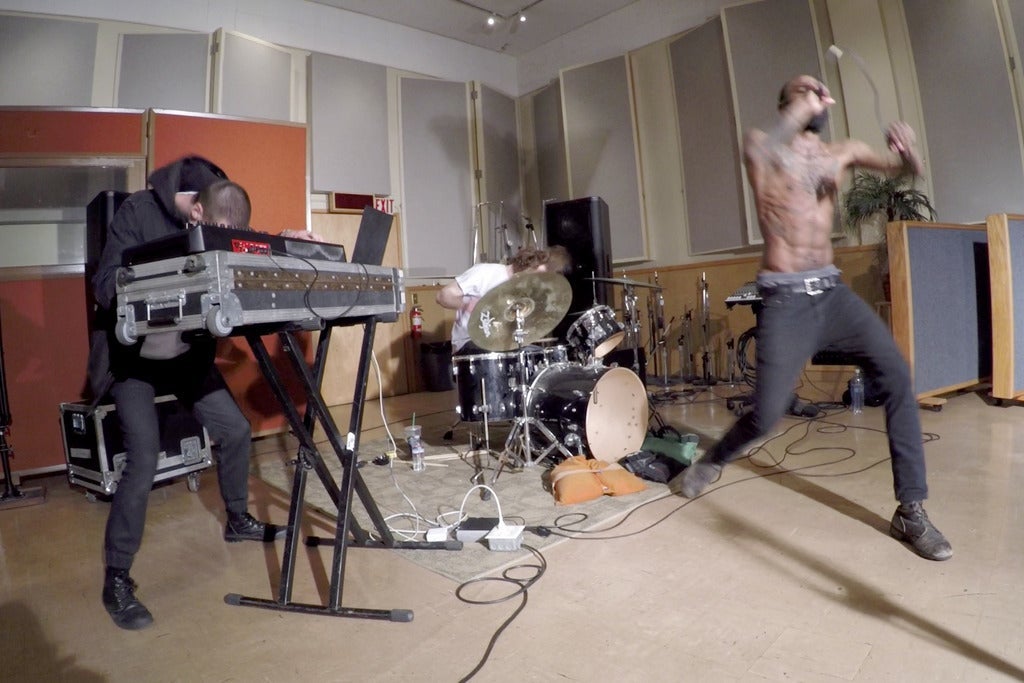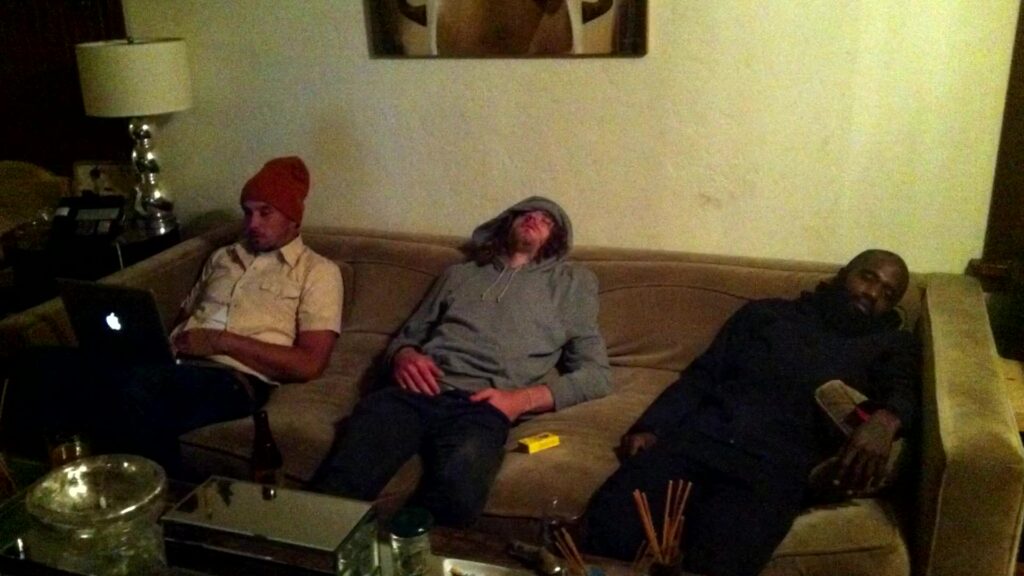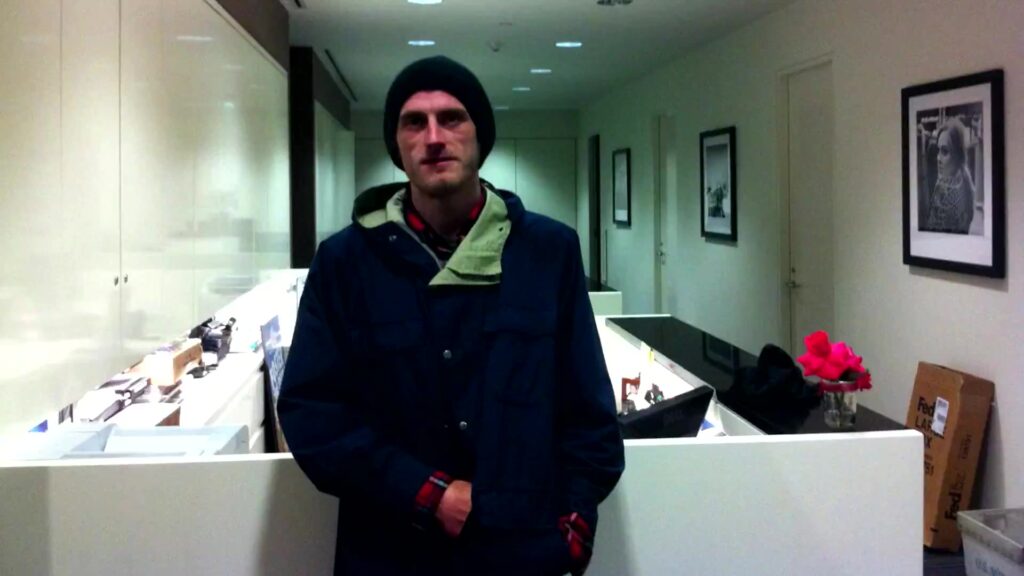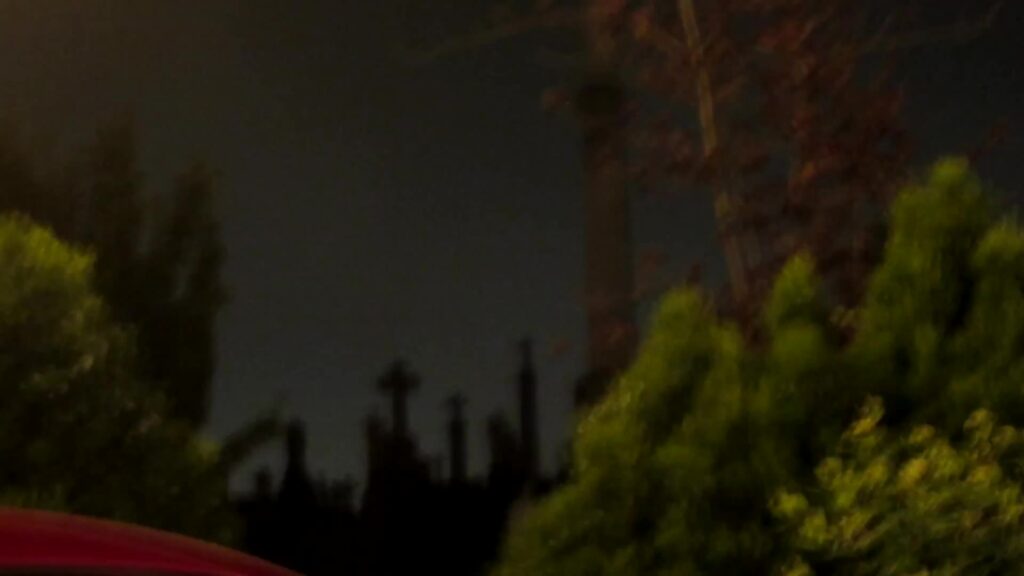A ruthlessly innovative art project grapples with reality, urine (yes, urine), and slowing down.

SAMUEL HYLAND
Death Grips are presumably named for the post-mortem phenomenon where deceased hands stiffen, barring them from releasing the things — often relatives — they died holding. The concept has long been a subject of fable and folklore, luring paranormal obsessives to the prospect of a rendezvous at life’s crossroads. When a living palm stops pulsating, the person holding it becomes something of a mortal chaperone, both witness and conduit to a transition from one existence to the next. But across Death Grips’ 13-year reign, as much as they’ve cast themselves as the deceased entity desperately clutched by millions, they’ve also made themselves difficult to identify as fully dead, fully alive, or fully trolling. A year after they released their debut mixtape Exmilitary via their website, they were swooped up by Epic Records; within months, they were dropped from the label for leaking (1) their own album, and (2) a set of frustrated emails from angry representatives. In 2013, after agreeing to a hyped set at that year’s Lollapalooza festival, they no-showed with zero explanation, prompting angry fans to mount the stage and destroy drummer Zach Hill’s drum kit. (To add to their macabre ethos, the group’s stage setup was backdropped by a screenshotted suicide note, presumably emailed to the band by a fan. “I’m not afraid of dying but i am afraid that I can’t hear DG in the after life if there is such a thing,” a portion of it read. “I don’t know, but I hope your music transcends to the unknown.”) Enigmatic frontman Stefan Burnett, who performs under the moniker MC Ride, is only confirmed to have spoken a handful of times outside of music; in one of his few existing recorded statements, he tersely declares himself to be “very distrustful of human beings in general.”

Death Grips’ lore hinges on the very-online predicament of admiring something that despises admiration: a cranny that demands relentless blank-filling, both to the pleasure of the admirer, and the chagrin of the begrudgingly admired. Where the punk-rap faction’s music is often studded with booby-traps and deterrents, it also nestles moments of nihilistic catharsis, seemingly unfit for bounds (or shelves) outside of their own creation. Among the most vulnerable Death Grips tracks is “On GP,” a six-minute opus that sees blaring lead-guitar choruses interspersed with slowed-down, aggro-punk riffage. Its final verse is something of a deconstructed suicide note, MC Ride’s destructive tilt assuaged by an unnamed “you” who allows him not to eliminate himself. “You wouldn’t believe all the nights I ain’t died for you,” he rasps, noticeably more sharp-edged in both delivery and sentiment. The song is second-to-last on the band’s 2012 double album The Powers That B — a stuffy project comprising two parts, Niggas on the Moon and Jenny Death, that were each initially received as individual records. In order to reach Death Grips at their most honest, you must first be willing to sit through the layers, sometimes entire albums thick, they’ve constructed to deter you from their truths. “I pull my face out the dirt slow,” MC Ride snarls, one track before his reimagined suicide letter. As consistently as he peels his visage from the dark, it’s implied that he never intends to show anyone, especially not us, the full thing.
Death Grips comprises vocalist Burnett, drummer-slash-producer Hill, and keyboardist-slash-producer Andy Morin. The trio rose to underground acclaim in 2011, when they quietly released a statement debut mixtape, Exmilitary, via their website. While the project spread like wildfire online, garnering niche cult status among indie blogs and fringe devotees, its creators remained largely in seclusion, denying interview requests and keeping tight-lipped about their identities. (For a while, the sole known member of the group was Hill, who had gained notoriety for his work in a math-rock duo called Hella.) Pitchfork called Exmilitary “unnerving when you’re not on its aggro wavelength, inviting when you are, and transfixing either way”; the Quietus dubbed it a “hyperstitious state of mania without hope of reprieve.” Not long later, in keeping with the self-slaughter central to their work, they broke their silence to offer a follow-up, Black Google, that featured all of Exmilitary’s instrumentals, isolated vocals, and stems. In a curt explanation posted to their website, they touted the sequel as “a portal” to the mixtape’s “deconstruction.”
“Death Grips was and always has been a conceptual art exhibition anchored by sound and vision. Above and beyond a ‘band.’ To our truest fans, please stay legend.”
Shortly after signing to Epic Records in 2012, the group announced that they would be releasing two new albums. The first of these, The Money Store, was a massive artistic and commercial breakthrough, despite lofty efforts to dissuade curious eyes and ears. Its cover featured an explicit drawing of a masochist, “Death Grips” carved into the skin above their breasts, on the leash of a female sadist smoking a cigarette. The inherent problem of a Death Grips devotee, oddly foreshadowed by The Money Store’s conundrum — fuck-you ethos, incredible sounds — remains that while their convolution is a programmed deterrent, it’s also the very thing that makes them a spectacle. NO LOVE DEEP WEB, the second album they’d release in 2012, was leaked against Epic’s permission; its cover saw Hill’s erected penis against an array of bathroom tiles, title scrawled across its shaft in sloppy Sharpie ink. (“If you look at that and all you see is a dick, I don’t really have anything to say, pretty much,” Burnett told a journalist that November.) May of 2017 welcomed the surprise-release of Steroids (Crouching Tiger Hidden Gabber), a 22-minute loosie track that many have since chosen to interpret as a cleverly-hidden LP. “Fuck praise,” MC Ride roars in the third of its eight noisy sections, “all it does is pay my bills.” Death Grips function best as a stanchion of nomadic fury: we know that they are angry, and maybe at us, but it is no one’s responsibility — not ours, not theirs — to draw parameters for their rage, even when it seems to need them most. They are explicit in wanting nothing to do with us. The moment we listen to their work, let alone speak on it, we are in the wrong.

In 2014, shortly after the surprise-release of Niggas on the Moon, Death Grips silently posted a napkin-scrawled breakup note to their Facebook page. “We are now at our best and so Death Grips is over,” it read. “We have officially stopped. All currently scheduled live dates are canceled. Our upcoming double album The Powers That B will still be delivered worldwide later this year via Harvest/Third Worlds Records. Death Grips was and always has been a conceptual art exhibition anchored by sound and vision. Above and beyond a ‘band.’ To our truest fans, please stay legend.” About a decade removed from the announcement, it’s common knowledge that the group would not, in fact, go on to halt all activity. But they’ve certainly died a number of deaths since inception, each one seeming to cast away an old identity in favor of new, just-as-amorphous skin. “Conceptual art exhibition,” for all its apparent pretension, feels like a far more fitting blanket for their shape-shifting sonic practice — an aggressive barrage of anti-genre ephemera that’s been simplified in terms ranging from “intelligent dance music” to “electropunk” to “industrial hip-hop.” Death Grips have long been infatuated with the art of destroying themselves, whether at the individual level (“On GP”), or as a collective (Black Google). With each act of self-destruction, though, comes the question of whether they’re serious this time, or trolling in the name of high, conceptual, aggro-art. As of the writing of this piece, it has been five years since the last full-length Death Grips album, the lengthiest interim period to date. Their long-term silence has had its fair share of one-off interruptions — like a merch collection released in collaboration with Praying, which featured an MC Ride-themed sleeping bag — but not without a gaping hole where music, discourse, and internet anarchy once thrived. Their situation feels vaguely reminiscent of Frank Ocean, another 2010s sensation who seems to have retired without officially saying so. The more silent both entities are, the more fans must put words into their mouths; the more words are put into their mouths, the less they need to say anything.
“As years-old Death Grips classics rained down from gargantuan line-array speakers, the crowd danced as if the group was present. They were not. And unlike the typical sold-out act, it wasn’t certain that they had ever considered coming in the first place.”
A few months ago, Death Grips hard-launched their resurrection with an Instagram post featuring dates for a North American tour. One recent night at Brooklyn Bowl, a bowling-alley-slash-venue in Nashville, loose clusters of dazed teenagers filtered into a dimly-lit hallway, black “X”-marks sharpied onto their scrawny wrists. Behind the venue’s velvet stanchion, a family of two adults and two children stood confused, wondering which line was for the bowling alley. A solemn-faced employee donning a referee jersey told them, in whisper-speak, that tonight was likely not the best night to bowl at this location.
Inside, a single-file merch line meandered past a set of bowling lanes, slouching towards a foggy ballroom replete with competing candy-flavored vape aromas. Near the bowling alley — a hilariously out-of-place, Weenie-Hut-Junior addition to the night’s macabre festivities — a young person no older than 17 shrieked, “Imagine bowling to Death Grips!!” Back went the heads of her high-school friend group, all hair dye, giggles, and distant parental chaperones. A few feet away, the scarlet showroom yielded a sea of dyed heads, bobbing towards a pitch-black stage. Even for Death Grips, the shadowy platform felt eerie in contrast to the beer-infused mingling occurring everywhere else. Atop it stood a pair of electric guitars, a modest drum set, a laptop, and a microphone stand. Missing, notably, was Morin’s synth setup. (On hiatus, he would be replaced by Nick Reinhart, a skilled guitarist who contributed to a majority of Jenny Death.) Looking out across the heads and into the black-hole-qua-stage, you got the sense that, more or less, this was all Death Grips had amounted to over the past several years: silhouetted instruments where there once existed all-out nihilism, its loyal devotees gathered in hopes that yesterday’s saviors might consider saving today, too. As years-old Death Grips classics rained down from gargantuan line-array speakers, the crowd danced as if the group was present. They were not. And unlike the typical sold-out act, it wasn’t certain that they had ever considered coming in the first place.

2018’s Year of the Snitch, Death Grips’ final album to date, opens with a percussive stomper titled “Death Grips is Online.” Though its lyrics offer few savored hints towards permanence, the promise of “online”-ness feels both genuine and tongue-in-cheek, a sly nod towards the sort of confirmation they never give in explicit terms. “Death Grips is online” can be interpreted, to the hopeful eye, as “Death Grips is alive”: not dead, not retired, not “over,” like they claimed to be on a napkin ten years ago. But at the same time, “Death Grips is online” is nothing particularly new, especially for an art project both born on the internet, and perennially found there when it doesn’t feel like existing in real life. The internet is a convenient place to die if you never intended on living, and oftentimes, when Death Grips return to their digital recesses, they seem to be preparing a grave as shadowy as their mythos. In 2012, they premiered a cryptic promotional video on the cult late-night channel Adult Swim. Across the clip’s eerie five minutes, where one might expect words, there are unsettling, somewhat voyeuristic cut-scenes: MC Ride cutting his hair into a mohawk; Morin’s shadowed face grinning in front of a ferris wheel; wreckage of Hill’s drum set sprawled across the floor of a barren rehearsal space. When Death Grips are online, they are just as intent on erasing themselves from the equation. The only difference is that they don’t have to answer questions while they do it.
By the time they were scheduled to play in Nashville, the spotlight of Death Grips’ North American tour had somewhat shifted towards their notorious fan-base. In a case like their own, where it’s easy to read irony into music more genuine than it’s given credit for, silence is a bit of a reputational risk — especially when you’ve shrunken so far back that crazed consumers must do all of the talking, and have been doing it for several years. Two days before their stop at Brooklyn Bowl, the band played at Union Transfer in Philadelphia, where an audience member went semi-viral for urinating on the ballroom floor. While the “Philly Pisser” made rounds online, digs at Death Grips fans grew more solid and more self-referential. A tongue-in-cheek quip about appropriate concert attire became a meta inside joke; at nearly every show since, at least one fan has come with a propeller hat, a rainbow-colored lollipop, and overalls. “Truly sorry for death grips for being a very sincere act with the worst fanbase,” one concerned tweeter wrote, the night before the Nashville show. “I can very much see why none of them interact with fans much.”
But by 8 PM, the strobe lights went out overhead, and there was no more hiding. As darkness fell over the crowd, screams of “We need you” and “let me see you” catapulted themselves towards the stage, flimsy darts against the stoic, unmoving shadow of MC Ride. Death Grips hadn’t deviated from the lengthy, 32-song “greatest hits” run-through they employed for a majority of the tour, but as intimidating as it looked on setlist.fm, it was often far less a collection of tracks than a wall of noise, familiar sounds interspersed with unfamiliar, ear-splitting aggro-frequencies. At certain points, a breathless MC Ride swaggered his way to a far side of the stage, sipping from a leaky water bottle between glares at the audience. With the apparatus for their ear-splitting noise fully revealed — Hill’s mile-per-minute drumming, Reinhart’s squealing guitar — it was difficult not to be reminded that, even beyond their digital graveyard, Death Grips were a vehicle for very human energy, and very human outrage.
“When they get inside to demand “hands up” with guns pointed, they’re shocked to find that the people they resent are madly in love with them.”
The group is often credited for extending a punk-rock lineage, pessimistic nihilism weaponized by forefathers like America’s Stooges and England’s Sex Pistols. In Please Kill Me, Legs McNeil and Gillian McCain’s oft-cited oral history of the punk movement, the Stooges’ Ron Asheton recalled his first time seeing the proto-punk band The Who. “It was wall to fucking wall of people,” he said. “It was my first experience of total pandemonium. The audience weren’t cheering; it was more like animal noises, howling. The whole room turned really primitive – like a pack of starving animals that hadn’t eaten for a week and somebody throws out a piece of meat.” Some fifty years after punk peeled the primal from the surface, as much as they’d never say it themselves, Death Grips effectively preserve tradition just as much as they attempt to break away from it. On the floor of the ballroom, moments after the performance, lay the decades-old residue of fringe catharsis: blood, sweat, and beers.
Some of Death Grips’ most effective work offsets the group’s ruthless, over-the-top innovation in favor of sultrier, more libidinal world-creation. “80808,” from 2016’s Bottomless Pit, sounds like a tongue slithering through your headphones and into your inner ear; Jenny Death’s “Pss Pss” centers around a synth riff as low-down-dirty as its story, a whispered wasteland of urination, licking, and fucking. These tracks share a quality perennially important to not only the groups’ music, but their legend: they function on the premise of knowing something that we don’t, and if not, being willing to say things that we aren’t. Listening to Death Grips feels like watching a lightning-fast home intruder guess the password to your property’s security system in real time. You know that they hate your guts, and that they wish nothing but death upon you, your belongings, and your family. But in busting through your door, they can’t help but invite a form of Stockholm syndrome — their victims are addicted to being wanted, addicted to being despised, addicted to having those feelings thrown back at them by a force desperate to fuck their minds. When they get inside to demand “hands up” with guns pointed, they’re shocked to find that the people they resent are madly in love with them.
One of Death Grips’ most popular tracks is “Hacker,” perhaps the most clear-cut iteration of their antagonistic, I’m-inside-your-house-motherfucker ethos. The song sees MC Ride play the role of a nefarious gangster, lofting a terrifying PSA over a barrage of synth stabs, distorted guitar squeals, and scattered, entropic noise elements. “I’m in your area,” he warns in its chorus — maybe speaking of his fictional gang on the prowl, or his real-life gang on the charts, forcing themselves into mainstream acclaim despite a laundry list of grievances about the ways they’ve gotten there. He has carved a path beyond the devices meant to keep him out, and he is hiding somewhere, eager to kill you. “I know the first three numbers — I’m in.”
“But even silence can be loud, painful, and ruthless — a fitting legacy for a band-slash-art-project that hated everyone, made it known, and may soon disappear for good.”
That night at Brooklyn Bowl, seconds after belting “I’m in,” MC Ride placed the microphone at his feet in one swift motion and walked out. Less than a month from now, assuming the 32-song setlist remains consistent through the tour’s conclusion, he will say the same words and do the same thing, perhaps for the last time. Though Death Grips are never ones to be explicit about future plans, most signs point to this being a twilight of sorts: they aren’t touring a new album; they’re touring hits from their most popular ones. Zach Hill is 43 and MC Ride is 45, grays increasingly prominent in his Shel-Silverstein beard. Where the 2010s saw rapid-fire productivity, the Death Grips 2020s have been mostly re-releases of old material, if not the usual silence.
But even silence can be loud, painful, and ruthless — a fitting legacy for a band-slash-art-project that hated everyone, made it known, and may soon disappear for good. In the immediate aftermath of the Nashville show, as ruffled college students smoked cigarettes and waited for Ubers along the venue’s walls, the most overwhelming sound was none of the usual suspects: not loose conversations, not phone calls to parents around the corner, not iPhone speakers, not late-night traffic, not random hollers, not an encore. It was tinnitus.
